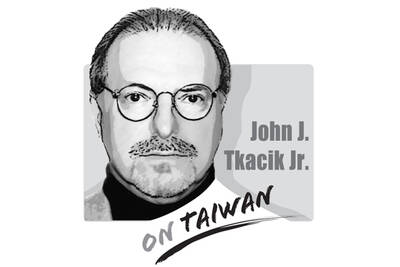Taiwan Semiconductor Manufacturing Co (TSMC) on Monday last week announced that it would invest US$100 billion to establish several more plants in the US. The news has attracted fierce criticism from many members of the Chinese Nationalist Party (KMT), spearheaded by former president Ma Ying-jeou (馬英九), who is claiming that the move would hollow out Taiwan’s resources.
However, remarks made by American Institute in Taiwan (AIT) Director Raymond Greene via the AIT’s official Facebook page made it clear that the US views the investment as emphasizing the deep connections between two global technological and economic powers, and represents a strengthening of Taiwan-US cooperation. In contrast, the KMT legislators are acting like China’s coconspirators.
The KMT — which survived by relying on US aid — has become a spokesperson for China, opposing the US at every turn.
TSMC’s move is to dispel external concerns about its investment in Intel and tariffs. Considering TSMC’s capital and global layout, US$100 billion is hardly an astronomical figure.
However, the company has earned the trust of US President Donald Trump, which is equivalent to obtaining a hall pass to freely enter the US market. Whether from the perspective of business competition or corporate governance, TSMC’s decision is wise and reasonable.
Taiwan has gained US recognition as a technological “powerhouse” — a powerhouse allied with the US. Greene also said that TSMC’s announcement “strengthens the economic prosperity and security of both the US and Taiwan.” From this, it is clear that TSMC’s investment would contribute to the nation’s security.
Looking back, when Taiwan’s tech industry was effectively a barren wasteland, it was the US that taught Taiwan about semiconductor technology. Did the US ever accuse Taiwan of “hollowing out” its resources?
TSMC founder Morris Chang (張忠謀) once said that although Intel was reluctant to acquire a stake in TSMC, it still placed large orders to help TSMC establish its footing.
Now, nearly half a century later, Taiwan’s semiconductor industry leads the world. Taiwan benefits from a democratic supply chain, and TSMC’s investment in the US is part of the two countries’ longstanding tech collaboration. Why attempt to exaggerate and paint it in such a negative light?
It was the US that aided the KMT so it could survive and rebuild after losing the Chinese Civil War. US military assistance is what allowed it to establish itself in Taiwan. Yet today, the KMT is consistently suspicious of the US and engages in anti-US rhetoric. Is their intention to drag Taiwan into China’s abyss?
Lin Tzu-yao is a doctoral student at National Taiwan University’s Department of Political Science.
Translated by Kyra Gustavsen

Somehow, US intelligence identified “the Houthis’ top missile guy” and pinpointed his exact location. At 1348 hours (Washington time), March 15, President Trump’s national security advisor Mike Waltz texted, “positive ID of him walking into his girlfriend’s building.” The unsuspecting Romeo entered. High above, the drone monitoring the building registered a flash. When the smoke cleared, Mr. Waltz texted, “…And it’s now collapsed.” RIP. The star-crossed “top missile guy” had been target number one in the now uproarious US Navy bombing campaign on that Sunday against the Yemeni rebels who have been holding the Red Sea hostage since October 19,
China on Tuesday, April Fool’s Day, began two-day joint-force military exercises around Taiwan, painting them as a “severe warning and forceful containment against Taiwan independence.” However, the exercises have again proven the country increasingly showcasing its military muscles to be a true “troublemaker.” Without prior notice, the Chinese People’s Liberation Army’s (PLA) Eastern Theater Command launched large-scale exercises codenamed “Strait Thunder-2025A,” deploying aircraft, drones and naval vessels including the Shandong aircraft carrier, as well as armed militia in the air and waters around Taiwan. The PLA claimed the military exercises were practice for precision strikes and a blockade to “close
Days ago, foreign media reported that Chinese People’s Liberation Army (PLA) Eastern Theater Command Director Lin Xiangyang (林向陽) is suspected to have disappeared under suspicious circumstances. The Eastern Theater Command is the core military department responsible for operations against Taiwan — the purging of its director, if true, would be a major blow to the morale of the Chinese military and the success of its training. On Tuesday morning — April Fool’s Day — the Chinese Communist Party’s (CCP) Eastern Theater Command suddenly announced the launch of joint military exercises in the air and maritime spaces surrounding Taiwan. The exercises
During the four-day Tomb Sweeping Festival holiday, many recall campaigns set up temporary stalls in their electoral districts to encourage more eligible voters to sign second-phase recall petitions. As of Wednesday, a total of 47 recall efforts — targeting 35 Chinese Nationalist Party (KMT) lawmakers and 12 Democratic Progressive Party (DPP) lawmakers — had advanced to the second phase, which requires signatures from at least 10 percent of eligible voters in the constituency within 60 days to proceed to a final vote. Nearly all recall petitions against KMT legislators cleared the first-phase review and launched their second phase between March 8 and